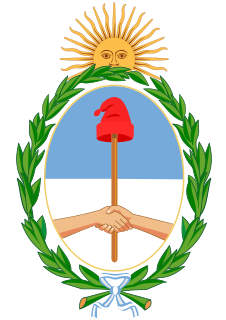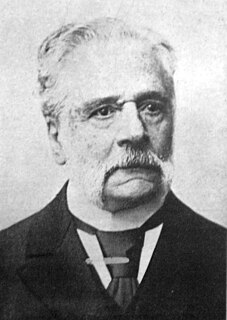
Agustín Pedro Justo Rolón was President of Argentina from February 20, 1932, to February 20, 1938. He was a military officer, diplomat, and politician, and was president during the Infamous Decade.

This article is about voting, elections, and election results in Argentina. For details of Argentine government institutions and political parties, see Politics of Argentina.

Argentina held presidential and parliamentary elections on Sunday, April 27, 2003. Turnout was 78.2%. No one presidential candidate gained enough votes to win outright, but the scheduled runoff was canceled when first-round winner Carlos Menem pulled out, handing the presidency to runner-up Néstor Kirchner.

Argentina held national parliamentary elections on Sunday, 23 October 2005. For the purpose of these elections, each of the 23 provinces and the Autonomous City of Buenos Aires are considered electoral districts.

Argentina held national presidential and legislative elections on Sunday, October 28, 2007, and elections for provincial governors took place on staggered dates throughout the year. For the national elections, each of the 23 provinces and the Autonomous City of Buenos Aires are considered electoral districts. Voter turnout was 76.2%.

The Argentine general election of 1995 was held on 14 May. Voters chose both the President and their legislators and with a turnout of 82.1%.

The Argentine presidential election of 1931 was held on 8 November. With a turnout of 73.4%, it produced the following official results:

The Argentine general election of 1928 was held on 1 April, with a turnout of 80.9%.

The Argentine general election of 1916 was held on 2 April. Voters elected the President, legislators, and local officials. The first secret-ballot presidential elections in the nation's history, they were mandatory and had a turnout of 62.7%.

Argentina held nine presidential elections between 1862 and 1910, every six years.

Ricardo Luis Alfonsín is an Argentine lawyer, academic and politician prominent in the Radical Civic Union. His father, Raúl Alfonsín, was the President of Argentina from 1983 to 1989.

Argentine legislative elections of 1912 were held on 7 April 1912 for the Argentine Chamber of Deputies. The first free, democratic elections in the nation's history, the contest had a turnout of 68.5% and produced the following official results:

The Argentine legislative elections of 1914 were held on 22 March. Voters chose their legislators, and with a turnout of 55.7%, it produced the following results:
The Argentine legislative elections of 1918 were held on 3 March. Voters chose their legislators and numerous governors, and with a turnout of 56.4%, it produced the following results:

Argentina held national presidential and legislative elections on Sunday, 23 October 2011. Incumbent president Cristina Fernández de Kirchner secured a second term in office after the Front for Victory won just over half of the seats in the National Congress.
The Argentine presidential election of 1880 was held on 12 April to choose the president of Argentina. Julio Argentino Roca was elected president.
The Argentine presidential election of 1886 was held on 11 April to choose the president of Argentina. Miguel Juárez Celman was elected president.
The Argentine presidential election of 1892 was held on 10 April to choose the president of Argentina. Luis Sáenz Peña was elected president.
The Argentine presidential election of 1904 was held on 12 June to choose the president of Argentina. Manuel Quintana was elected president.
The Argentine presidential election of 1910 was held on 13 March to choose the president of Argentina. Roque Sáenz Peña was elected president.

















